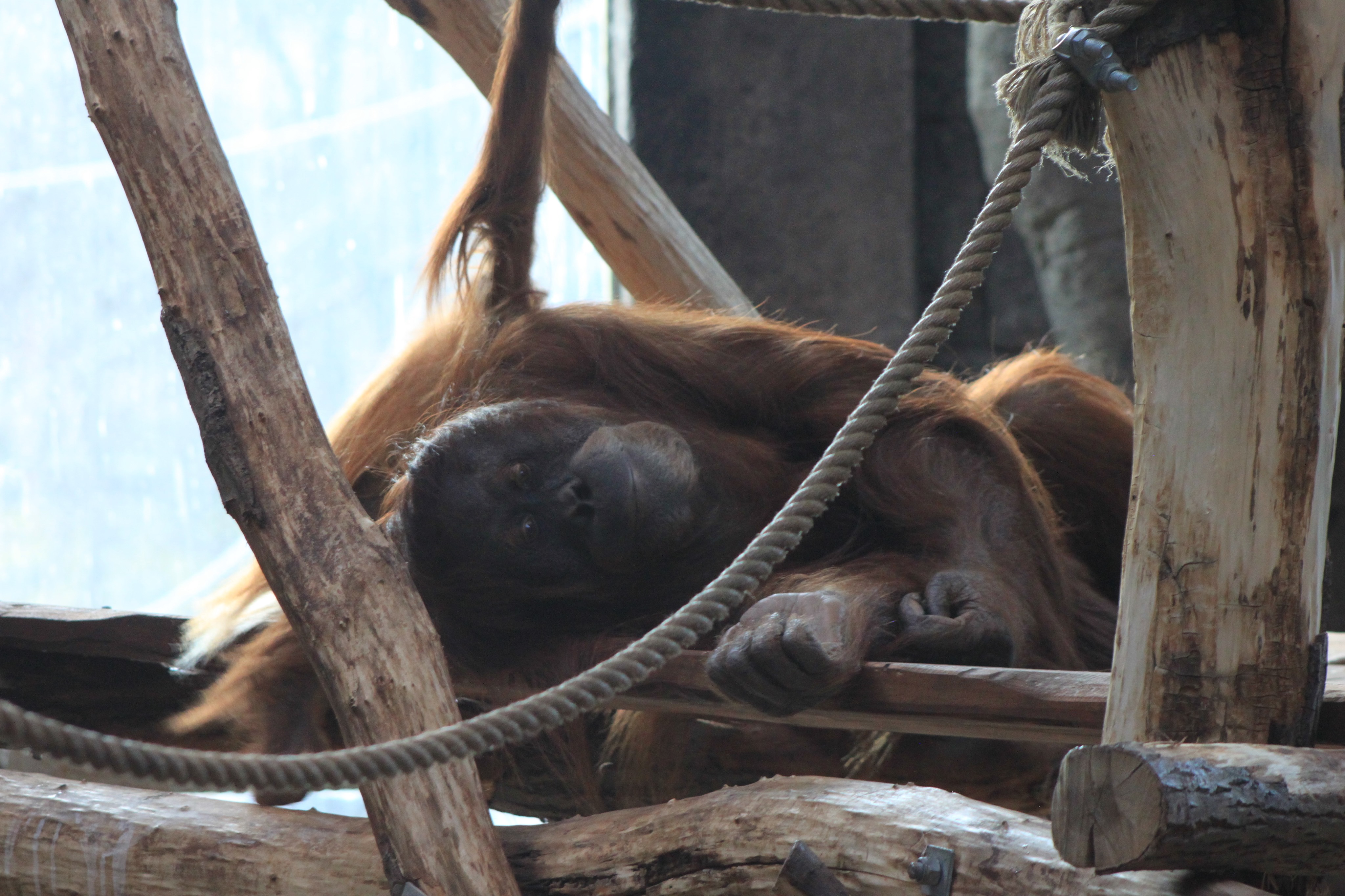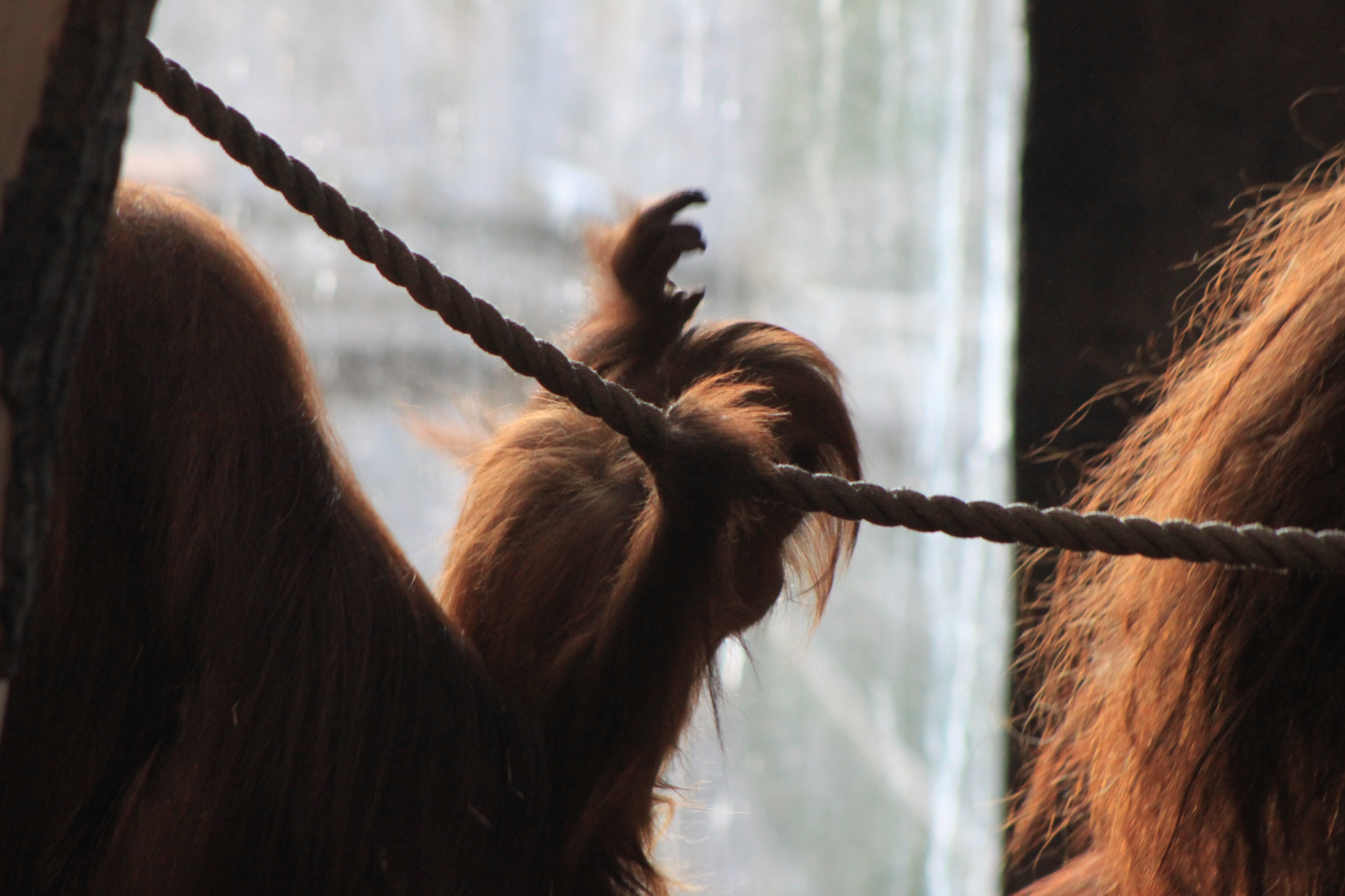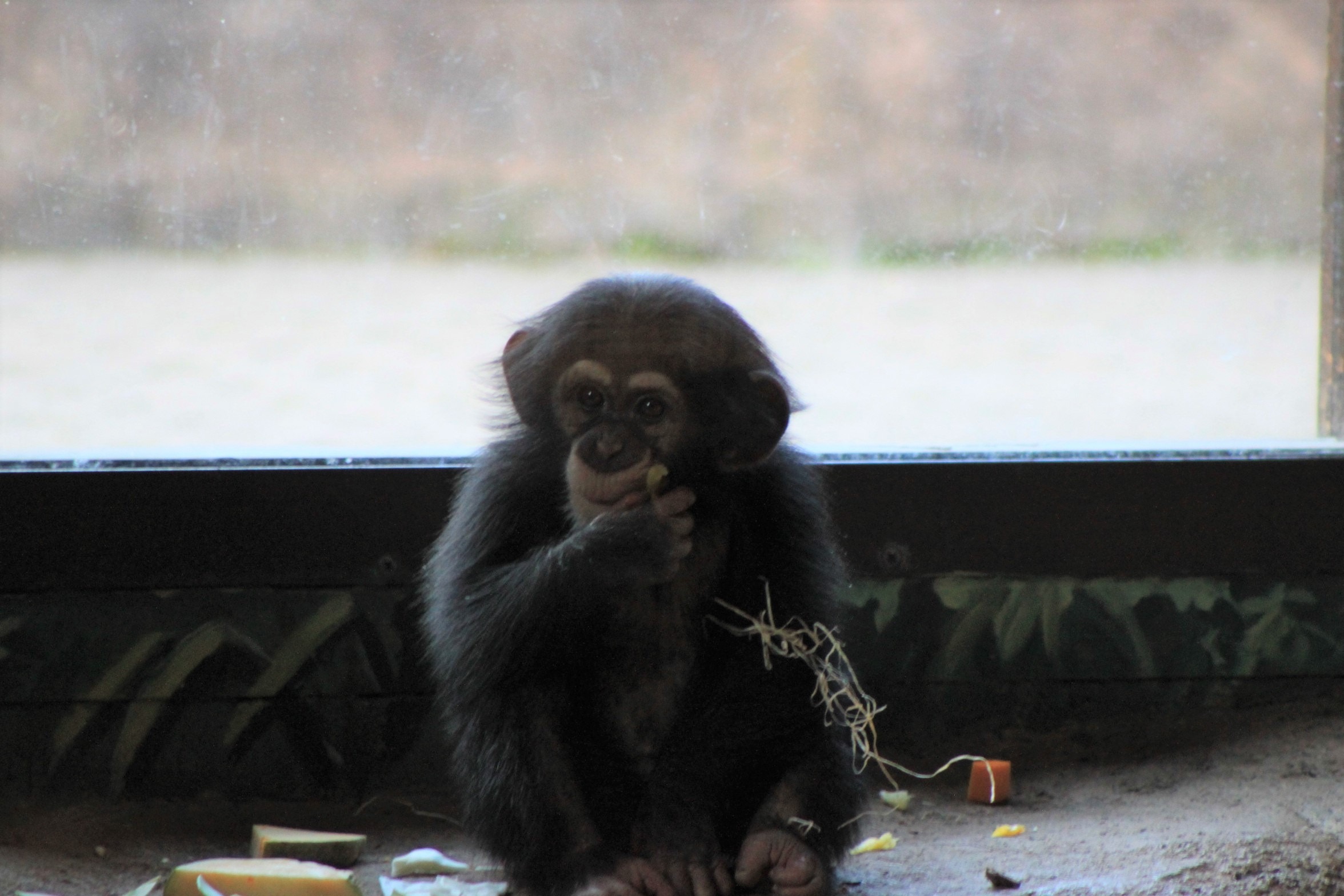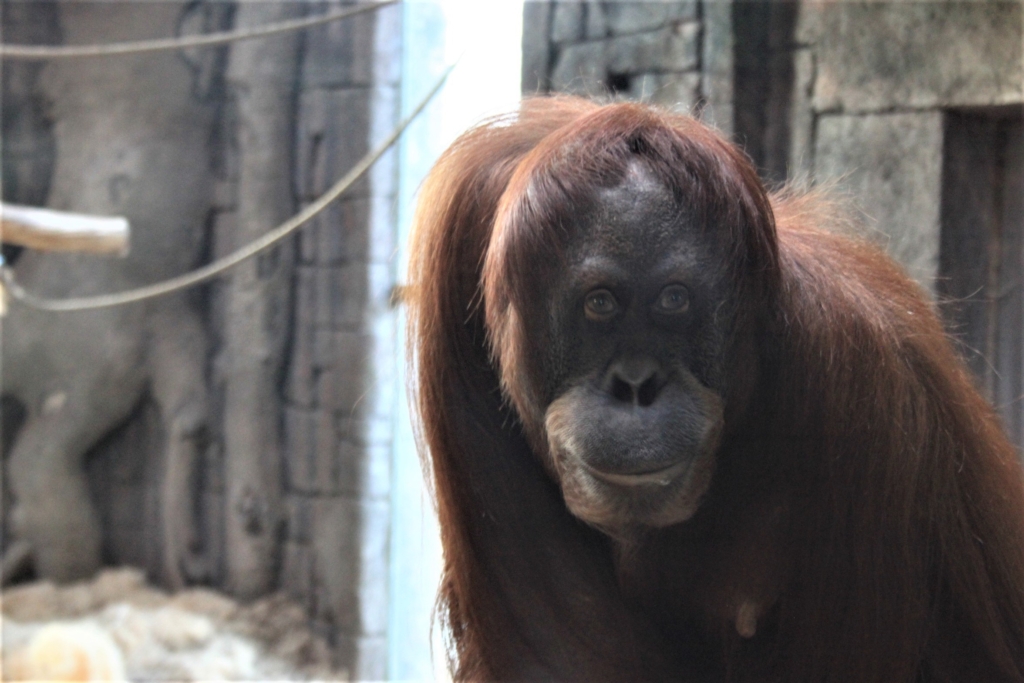Modern research into animal cognition indicates that many animals are capable of much more than we have previously thought. These developments present us with new scientific and ethical challenges. How do we deal with that which is nearly human?
It’s winter, around zero degrees, and I’m at Furuvik Zoo in northern Sweden. I’m here on a research excursion as part of my master’s programme in cognitive science, for a first-hand look at the Lund University Primate Research Station facilities and the animals housed at the zoo.
My guides are Tomas Persson, Scientific director at the primate research station, who doubles as Head of the Department of Philosophy at the university; and Gabriela-Alina Sauciuc, a researcher at the philosophy department and the Division for Cognitive Science (LUCS). Her work with LUCS focuses on representational abilities and motor synchronization, including developmental trajectories. Among other things, she is researching the development and evolution of social cognitive capacities in human and non-human great apes.
Cognitive science is the study of thought and information processing. Often, this includes the study of animal minds. For Tomas Persson, understanding great apes has been a lifelong pursuit. After studies in psychology in Lund and anthropology and primatology in London, he returned to Lund to pursue a PhD, studying primates’ ability to understand iconic artefacts, such as pictures.
Looking back, he gives a short laugh. “As a student you don’t have a great understanding of labor markets”, he says, but soon becomes serious. “Apes are interesting in themselves, without any comparisons with humans. But that kind of comparison is one important reason to study them.”
Studying the minds of great apes, explains Tomas Persson, is a way of understanding human cognitive evolution.
This perspective ties into a much older scientific body that encompasses not only behaviour itself, but its underlying biology.

The geneticist Theodosius Dobzhansky famously stated that nothing in biology makes sense except in the light of evolution. That was in the 1940’s, and that light has since grown to encompass not only the bodies of creatures on this planet, but their minds also.
Evolution leaves many tracks but never any witnesses, and scientists seeking to uncover its workings must often work by inference. The LUCS Primate Research Station at Furuvik studies the behavior of Sumatran orangutans and chimpanzees. Both species are part of the taxonomic group Hominidae, or great apes, which also includes gorillas and humans. Many behaviors found in humans can thus be studied through comparisons with these related species. I’m soon introduced to one poignant such example.
In the winter season, the zoo is closed. The apes are kept inside until the risk for ice formation is past, usually by the middle of April. The zoo is quiet and still as Sauciuc leads the way to the orangutan enclosure.
Furuvik Zoo is home to three orangutans, a male named Naong, a female named Dunja, and their two-year-old offspring, Indah, another female. Indah is the first Sumatran orangutan to be born on Swedish soil, and to the zoo, her presence has been a great source of pride. To primate researchers, this little family provides ample opportunity to study the evolution of parenting.
“Systematic studies on maternal competence in apes have been relatively rare for the first months of life”, explains Sauciuc. “This is probably due to many ape mothers, especially chimpanzees, usually taking ‘maternity leave’, that is, isolating themselves from the group at the time of birth, to a few months after.”
Additionally, unlike humans, apes are not always visibly pregnant. This combination of factors makes systematic study in the wild difficult. Recently, however, scientists have made progress studying captive subjects. “One study indicates that levels of maternal competence vary with levels of oestrogen and progesterone during pregnancy. Oxytocin during the period after birth also plays a role in maternal attachment. Taken in all, it seems to be a matter of whether hormonal levels reach a threshold sufficient to facilitate mother-infant bonding.”
Inside the great enclosure, Dunja’s attention never strays far from her offspring. As little Indah climbs, Dunja’s often pays as much attention to Indah’s movements as she does to her own doings. “Dunja seems to have had the hormones on her side”, says Sauciuc. “She immediately engaged in the expected behaviours. Here we are currently trying to investigate how she structures Indah’s learning experience, such as by encouraging or hindering particular actions.”

While the study is still in progress, a premature conclusion suggests that Dunja might be tailoring these structuring behaviors based on an assessment of the infant’s competence. “For a couple of months, Dunja would remove all objects Indah tried to put in her mouth, but when Indah began teething, Dunja no longer interfered with this form of exploratory behaviour. Dunja also deploys playful diversions when interfering in this way. She’s a wonderful mother.”
Pregnancy hormones in a great ape will no doubt prove a surprising topic to many. It is far from how we tend to think about animals, seemingly crossing that invisible border that separates man from his other fellow creatures. The empiric facts appear to underline everyday similarities that we are prone to disregard. This is far from the only example. We continue our tour and head for the chimpanzee enclosure.
Off limits to visitors, a small side door takes us to the research station, where only a wall of steel fence and glass separates us from the space where the animals are held. We are soon greeted by the curious apes.
After many years of going back and forth between Lund and the zoo, the chimpanzees recognize Tomas Persson. One female, Selma, is particularly friendly today, knowing that he often has treats with him. She attempts to trade him a plastic tube, pushing it through the bars, which is soon rewarded as Tomas Persson hands her a few raisins one by one.
The mental capacities of apes is often surprising to the uninitiated, which in some regards is understandable. While humans easily infer mental states in others, animals’ own lack of spoken language makes them easy to disregard. But empirical results are in line with what many animal researchers have been saying for years.
The cognitive mechanisms regarded by science as uniquely humans are growing few. But this transition has been slow. The hallmark of comparative cognition is to contrast some non-human species’ ability in a given cognitive domain to that of humans. For a long time, animals performed poorly in such comparisons. One reason, explains Tomas Persson, is that given somewhat different tasks, children and chimpanzees have not always been treated similarly. “Children are often given verbal instructions. And so, in, for example, choice tasks, they understand they have a choice to make”, he says and continues: “With chimpanzees, you can’t do that. You make the assumption they understand they have a choice to make, which is not really given at all. So what do you do? It’s a very difficult methodological question.”
He continues: “In general, chimpanzees are not so communicative in nature. That’s not to say that chimpanzees do not collaborate, that’s much too simple. But we humans do communicate differently, that much is very true.”

Another domain where chimpanzees might have been misjudged is that of social dynamics. For a long time, they were believed selfish, but more recent research indicates that they recognize, understand and adapt to group members in a way that is much more like ours than we have previously thought.
Sauciuc notes that what we call friendship, which in animal studies is known as coalitions, has mainly been studied in males. “By now it’s known that allies will hoot, patrol and food grunt together. There’s also some evidence of male-female ’friendship’. Female-female relationships are often harder to study, as grown females are often busy caring for offspring, or even surrounded by them.”
This is a topic that might have to be left to other research stations, however, as there are only seven chimpanzees at Furuvik – a relatively small group. In addition, Linda, a female, has been the adoptive mother of two others in the group, complicating the relations. “We’re currently collecting data at Kolmården Zoo, however, where we hope to investigate affiliation as a potential predictor for certain social behaviors”, says Sauciuc.
This does not mean that sociality is being left out at Furuvik. For the last few years, the group has been investigating the origins of rhythmicity and musicality in the zoo’s chimpanzees. “One chimpanzee in particular is interesting in this regard. Linda sometimes exhibits eye-catching rocking behaviors as she moves forward, pushing piles of wood wool ahead of her.”
Such behaviors have previously been described as abnormal, but Sauciuc thinks it might be time to rethink that assessment. “After all, humans also exhibit a range of rocking or swinging movements, which are sometimes recruited into, for example, dancing and children’s play. We experience them as pleasurable. This behaviour is a kind of vestibular stimulation that we seek rather purposefully, and we’d like to reconsider Linda’s rocking from this perspective”, says Sauciuc and continues: “We aim to track the presence, forms and extents of rhythmic behaviours, and map the contexts in which they occur. Hopefully, we’ll be able to understand the functions of such behaviours”.
My day at the zoo at an end, I go back to Lund. But I realize there is one important dimension of this issue has been left out. After all, animal cognitive research finds itself in something of an ethical trap. To many, the more we learn about the mental lives of animals, the more questionable the prospect of conducting research on them at all. To discuss these questions, I ask to meet with Tomas Persson in his office at the department.
Findings that support the view of other great apes as cognitively capable and complex creatures raises difficult ethical considerations. While the research at Furuvik is harmless and performed on basis of willing participation (the apes can leave whenever they wish), some are unconvinced by this argument.

Tomas Persson agrees that ethics in the context of animal research, even cognitive, is a complex one. He is sceptical that any one-sided answer will account for the many relevant variables. “You might try asking, where are apes the happiest? Well, wild chimpanzees are found in African forests, that’s their natural habitat. But those forests are not very safe places.”
Both orangutans and chimpanzees are threatened species in the wild. Among other factors, deforestation presents a great threat to their natural way of life.
Great apes are also slow to reproduce. A chimpanzee female will give birth only once every five years, and an orangutan only once every eight years. The result is that even if left alone, these animals would take generations to reach healthy population status.
Keeping these animals in captivity, while ethically questionable to some, may in fact be in the interest of preserving the species with the hope of one day reintroducing the animals into the wild. “I think the best thing you can do is to aim for zoos and parks to take as good care of their animals as possible”, says Tomas Persson. “For researchers, if you can do what you need to in a way that is less painful, less wasteful, then that’s what you should do. If you can do computer simulations that have the same pedagogical benefits as, say, dissecting a rabbit, then you should do that.”
He continues: ”There’s a lot of rules set up around this kind of thing. If everything works the way it’s supposed to, we should be able to trust that the animals are being treated decently and are living decent lives”.
We’ve been asking ourselves how we are different from other animals for hundreds of years. It’s time we start paying attention to what we have in common. The truth is that in all likelihood, human consciousness is unique to humans, but that’s far from saying we are the only conscious beings.
Just as humans, orangutans can prove to be warm and nurturing mothers, and in both species these behaviors are regulated by similar chemicals. Chimpanzees have significant understanding of group dynamics, and might be using rhythmic behaviors in similar ways we do.
These are inspiring observations, to be sure. We have much in common with our nearest relatives, and much still to learn about this relationship. Yet these insights also come burdened with urgent concern.
If these creatures were lost to the world, we don’t know what kind of light would be extinguished.









